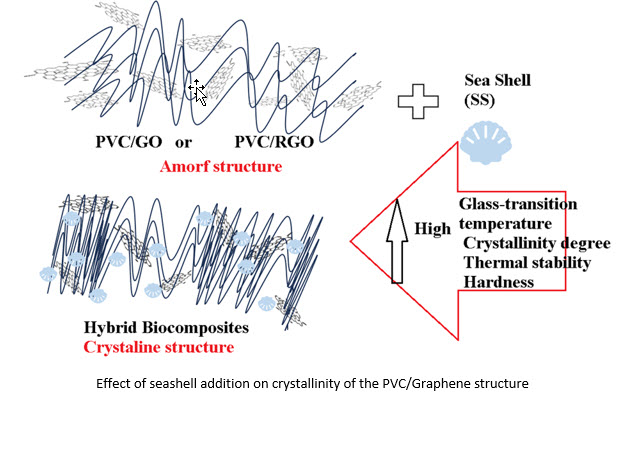Wed, Jan 29, 2025
[Archive]
Volume 21, Issue 4 (December 2024)
IJMSE 2024, 21(4): 91-102 |
Back to browse issues page
Download citation:
BibTeX | RIS | EndNote | Medlars | ProCite | Reference Manager | RefWorks
Send citation to:



BibTeX | RIS | EndNote | Medlars | ProCite | Reference Manager | RefWorks
Send citation to:
Mindivan F. Study on Crystallization of PVC/Graphene/Seashell Hybrid Biocomposites by Thermal and Hardness Analysis. IJMSE 2024; 21 (4) :91-102
URL: http://ijmse.iust.ac.ir/article-1-3676-en.html
URL: http://ijmse.iust.ac.ir/article-1-3676-en.html
Abstract: (3887 Views)
Natural-reinforced hybrid composites, called "eco-materials," are becoming increasingly important for protecting the environment and eliminating waste problems. In this study, hybrid biocomposites were produced by the colloidal mixing method using seashell (SS) as natural waste, two graphene derivatives (graphene oxide (GO) and reduced graphene oxide (RGO)) as filler material, and polyvinyl chloride (PVC) as the polymer matrix. The crystallization and mechanical properties of hybrid biocomposites were examined based on their thermal properties using TGA and DSC analysis. In comparison to PVC/GO and PVC/RGO composites with identical weight percentages of GO and RGO, the PVC/GO composite exhibited superior thermal stability and crystallinity, resulting in elevated hardness values for the same composite. These results were attributed to the better interaction of GO with PVC due to the higher number of oxygen-containing functional groups in GO than in RGO. However, the PVC/RGO/SS hybrid biocomposites exhibited superior properties than PVC/GO/SS hybrid biocomposites. The greatest crystallinity values were 39.40% for PVC/RGO/SS-20 compared to PVC/RGO at 20 wt% SS content and 29.21% for PVC/GO/SS-20 compared to PVC/GO. The PVC/RGO/SS-20 hybrid biocomposite showed the greatest gain in hardness value, up 18.47% compared to the PVC/RGO composite. No significant change was observed in the melting and weight loss temperatures as the SS content increased; however, the crystallinity and glass transition temperatures in hybrid biocomposites increased as the SS content increased. All analysis results demonstrated the achievement of SS-graphene-PVC interactions, suggesting that SS waste could enhance the thermal and mechanical properties of composite production.
Type of Study: Research Paper |
Subject:
Synthesis and preparation of materials to meet the requirements of AM techniques
Send email to the article author
| Rights and permissions | |
 |
This work is licensed under a Creative Commons Attribution-NonCommercial 4.0 International License. |








